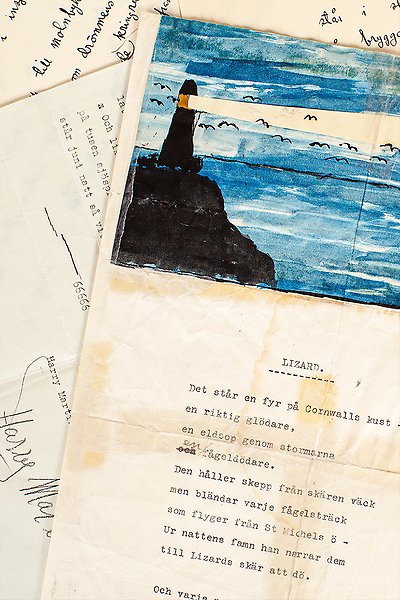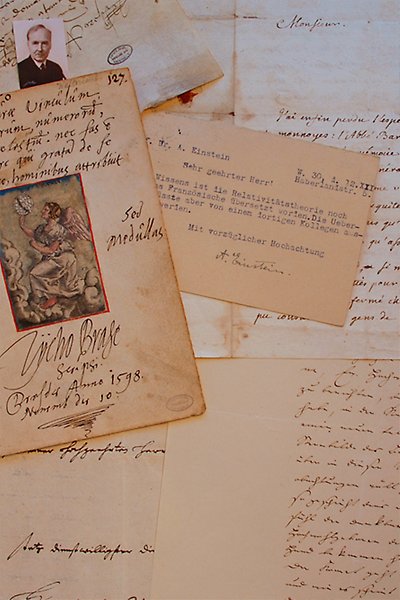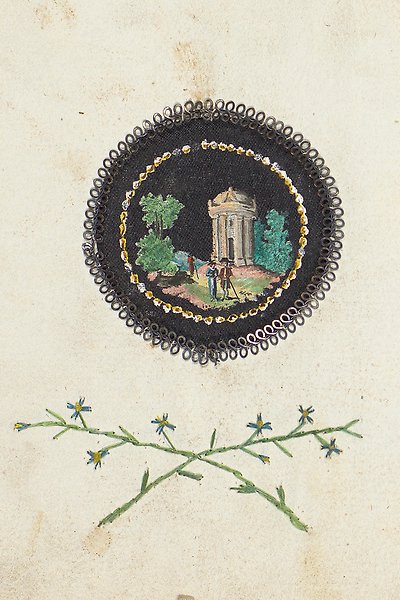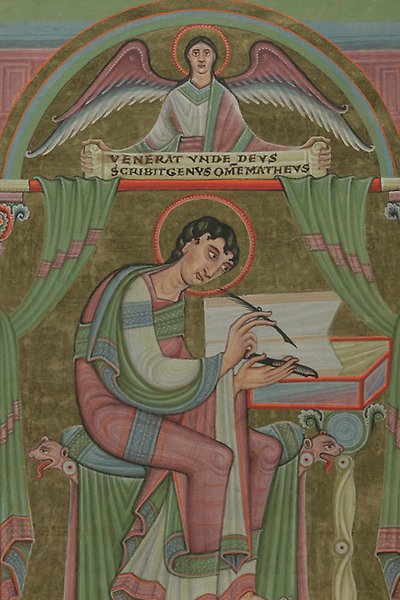Manuscripts, letters and archives
Our manuscript collections (manuscripts, letters and archives) contain handwritten documents from all periods, from the 6th century BC to the present day. You will find everything from Egyptian papyri and medieval parchment books to early modern diaries and letter collections, as well as contemporary research archives containing digital material. A common feature of this material is that it is not printed.
The majority of the Library's manuscripts are subject-based, but there are also many smaller collections that may share a common previous owner, a common language or a common writing material. These are called "Specific Manuscript Collections".
Search with the Index to the Manuscript Collection
The Index to the Manuscript Collection is a gateway to the Library's manuscript catalogues. Here you can search for personal names and find references to letters and manuscripts in various collections and archives. The information points to other catalogues, where you can read more about the manuscript, but you can also request items directly from the index.
Search in the Index to the Manuscript Collection
Search by subject
In the larger, older part of the manuscript collection, the manuscripts are sorted according to the subject they were thought to cover. The subject-related manuscripts are described in a typewritten catalogue, which is also scanned. You can select the subject you are interested in and look in that sub-catalogue. You can also search for words in full text in individual catalogues, or in all the subject catalogues simultaneously. Detailed search help is available inside the catalogue:
Search the Subject Manuscript Collection
Search in the Specific Manuscript Collections
Partly outside the subject collection are the so-called specific manuscript collections. These are manuscripts that have been donated to the library by a particular person, or manuscripts that have some other important common denominator such as shield letters, parchment letters or papyri.
Manuscripts in the specific manuscript collections can usually be found via the same search routes as manuscripts in the subject collection, but not always. Sometimes additional catalogues are used.
Examples of Specific Manuscript Collections
- De la Gardie Collection – in 1669 Magnus Gabriel De la Gardie donated 65 volumes of mainly Nordic history and older works, one of which is the Codex argenteus and another Snorri Sturluson's Edda which is also known as the prose Edda, or the Uppsala Edda.
- Gustavian Collection – documents from the Swedish king Gustav III, as his manuscripts, letters from and to the king, and a large amount of other documents concerning Swedish history. Due to fragile condition, this collection is not available for request and study in the Special Collections Reading Room.
- Ihre Collection – contains mainly of Johan Ihre’s manuscripts and documents, mainly historical and linguistic works, including runology. There are also books on topography, travel books and medicine.
- Linnaeus Collection – about twenty original manuscripts by Carl Linnaeus, some of which are extremely early, as well as just over 200 letters in his own hand.
- Nordin Collection – the collection is named after Bishop Carl Gustaf Nordin and contains original documents and copies concerning Swedish political history, ecclesiastic history, law and the history of learning.
- Palmskiöld Collection – around 500 volumes of notes and copies mainly of political and topographical documents, even Swedish biographies from the 17th and early 18th centuries, collected by the archivist Elias Palmskiöld during the 1700s. The collection also contains a number of rare early printed works.
- Waller's Autograph Collection – the surgeon and book collector Erik Waller’s collection of letters and other original manuscripts from scientists, doctors, philosophers, humanists, politicians and explorers from all over the world, from the Middle Ages to the 1950s. All the documents have been scanned and are available online.
- Westin Collection – in 1877 the book collector Jacob Westin donated his collection, mostly containing materials in biography, history and topography with a focus on Stockholm.
Search by type of manuscript
Archives
Search for archives
Most individual archives held in the Library are registered in Alvin. However, many archives still need to be searched on site at Carolina Rediviva using the catalogues available in the Special Collections Reading Room or with the help of staff.
Different types of archives
Uppsala University Library holds archives of authors, theologians, historians, politicians, artists, musicians and other cultural celebrities. There are approximately seven hundred personal archives of individuals and nearly one hundred family archives. Institutions and organisations have also donated their s to the Library. These include the magazine Ord och Bild and the folk-dance organisation Philochoros. The archives vary in size from single volumes to hundreds of shelf metres.
- Personal archives – everything from the first notebooks of school days to diaries, guest books, almanacs, hastily written scattered thoughts about life, cash books, official correspondence and sometimes thousands of private letters to and from relatives and friends. Personal archives often contain photographs, drawings and other visual material. The archives include manuscripts and correspondence from Carl Larsson, The Svedberg, Gustav III, Stina Aronson, Gustaf Fröding, Harry Martinson, Sara Lidman and many others.
- Author archives – manuscripts of works of fiction.
- You can track the history of collective scientific endeavours in the archives of academics and scientists.
- Archives of the clergy – sermons reflecting lifelong ministries.
- Institutional and association archives – documents such as annual reports, minutes, correspondence and ledgers. Here you will also find the archive of the Institute for Racial Biology.
- The archives of Uppsala Student Nations are deposited at Uppsala University Library. Student life and the activities of the Student Nations from the 17th century onwards are reflected in minutes, accounts and other documents. The Student Nations' membership registers also contain information about individual students. New archive material may remain at the respective student nation. Records of the student nations' material at the University Library.
Documents from Uppsala University
The Uppsala University Archives (UUA) are not kept at the University Library but in the University Archives in the Segerstedt Building. This also includes the faculty and departmental archives as well as maps and plans of the University's properties. It is possible to request older material from the UUA for the Special Collections Reading Room at Carolina Rediviva. Read more about UUA on the Employee Portal.
Donate archives
The Library continues to accept donations of manuscripts and archives from individuals and organisations. Read more about how to donate an archive, a manuscript or other unique or rare material to the Library:
Donate archives to Uppsala University Library

Items from Harry Martinson's archives.
Autographs
Search for autographs
Start by searching The Library Search Tool., Libris and Alvin. If you don't find what you are looking for, you can proceed to the
- Catalogue of Section Y – section Y contains Swedish and foreign autographs (handwritten manuscripts, family books, almanacs, numismatics, art history, music history).
Content of the Autograph Collection
An autograph collector collects documents that famous and less famous people have written in their own handwriting. This can be a person's signature, but also scribbled notes, long letters or poetry manuscripts. You can find original letters written by some of the most famous people in world history.
See a selection of our autograph collections
- Waller's autograph collection (also known as Waller's manuscript collection) contains around 38,000 autographs from all over the world. These are mainly letters from doctors and scientists, but also prominent humanists, politicians, inventors and explorers. Examples include Ampère, Pasteur, Linnaeus, Tycho Brahe, Einstein, Kant, Newton, Darwin, Voltaire, Napoleon and James Cook. The collection ranges from the Middle Ages to the 1950s.
- Barthelson's autograph collection – mainly Swedish autographs, from the 16th century to the turn of the 20th century.
- Dörfler's autograph collection – letters written by botanists, from the 17th to the 20th century.
- Gustafsson's autograph collection (Y 6:1-48) – mainly Swedish, but also foreign autographs, from the 1500s to the 1960s.
- Sahlgren's autograph collection (Y 5:1-16) – mainly Swedish autographs, from the 17th to the 20th century.
How did the Library acquire the Autograph Collection?
The autograph collections in the Library were either purchased by the Library or donated by private autograph collectors.

Autograph albums
Search for Autograph albums
Autograph albums are found in the subject collection under subject letter Y. The autograph albums are catalogued and digitally available in the Alvin database. You can search both the name of the owner of the autograph album and the names of the different people who wrote greetings in the book. You can also search by location.
- Handskriftskatalog Y: Autografer och s.k. minnesböcker, Handskriftskatalog Z: Numismatik, konst, musik
Autograph albums and their owners
Uppsala University Library’s collection of autograph albums is the largest in Sweden. It includes approximately 150 autograph albums from the late sixteenth century through the first half of the twentieth century. There are autograph albums here of major cultural and historical interest, such as those of botanist Carl Peter Thunberg, baroness Magdalena von Beskow, poet and professor of aesthetics in Uppsala Carl Wilhelm Böttiger, Princess Cecilia of Sweden (daughter of Gustav IV Adolf), and the author Ernst Malmberg.
The total number of inscriptions amounts to approximately 11,200. They include entries from Carl Linnaeus, H.C. Andersen, Alexander von Humboldt, Isaac Newton, Goethe, Esaias Tegnér, Per Daniel Amadeus Atterbom, Erik Gustaf Geijer, Fredrika Bremer, Victor Hugo, Knut Hamsun, John Bauer, Elin Wägner and more.

Page from Johann Friedrich Cruse's autograph album: Watercolor on linen laced with metal threads with silk embroidery underneath, c. 1777–1800.
Letters
Search for letters
Start by searching in Alvin. You can start by searching for a particular person's legacy papers, or 'archive'. If you don't find what you are looking for, you can move on to the following catalogues:
- Catalogue of Letters (older letters) This catalogue provides information on the letter writers for which there are letters, along with their recipients.
Search the Catalogue of Letters - Bruno (many younger letters) Due to data protection laws, this catalogue is not accessible outside the library and can only be used in the Special Collections Reading Room.
Individual letters may also be included in subject collections or in modern archives.
Some overlap – search both catalogues and Alvin
There is some overlap between the catalogues, and as there is no exact time limit between them. You should therefore always search both Brevindex and Bruno.
Different types of letters and collections of letters
A letter collection usually consists of letters, postcards, postcards or telegrams sent to a specific person or institution. Letters sent by the individual to others are usually found in the letter collections of others, if they have been preserved. However, some letter collections also contain outgoing letters. These may be saved drafts or letters that the person has sent in the past but received back. The letters sometimes have attachments, such as photographs, newspaper clippings, lists, pressed flowers or drawings.
The letters are often part of an archive, but there are also other types of collections that contain letters. One example is autograph collections, where a person has purchased or otherwise collected letters written by famous people.
The Library holds correspondence from Gösta Knutsson, Malla Silverstolpe, Harry Martinson, Carl Larsson and Sara Lidman, among others.
How did the Library acquire the Letter Collections?
Most of the Letter Collections were acquired by the Library through items being submitted by a certain person or institution.

Oriental Manuscripts
Search for Oriental manuscripts
Start by searching in the Library Search Tool, LIBRIS and Alvin. If you do not find what you are looking for, you can move on to the following catalogues (some of which are available digitally and others are only available in physical form at the library):
- Tornberg, C. J., Codices arabici, persici et turcici Bibliothecae Regiae Universitatis Upsaliensis, 1849.
- Zetterstéen, K. V., Verzeichnis der hebräischen und aramäischen Handschriften der Kgl. Universitätsbibliothek zu Uppsala, 1900.
- Zetterstéen, K. V., Die arabischen, persischen und türkischen Handschriften der Universitätsbibliothek zu Uppsala, 1, 1930.
- Zetterstéen, K. V., Die arabischen, persischen und türkischen Handschriften der Universitätsbibliothek zu Uppsala,2, 1935.
- Zetterstéen, K. V., “Report on the manuscripts left by the late professor O.F. Tullberg and now in the library of Uppsala University”, in: Le Monde oriental, 1907, Fasc. I.
- Löfgren, Oscar, Katalog über die äthiopischen Handschriften in der Universitätsbibliothek Uppsala sowie Anhänge über äthiopische Handschriften in anderen Bibliotheken und in Privatbesitz in Schweden, 1974.
- Eimer, Helmut, Tibetica Upsaliensia: Handliste der tibetischen Handschriften und Blockdrucke in der Universitätsbibliothek zu Uppsala, 1975.
- Lewin, Bernhard & Oscar Löfgren, Catalogue of the Arabic manuscripts in the Hellmut Ritter Microfilm Collection of the Uppsala University Library: including later accessions. Edited by Mikael Persenius. 1992.
- Muhaddis, Ali, Fihrist-i kitāb'hā-yi khaṭṭī-i fārsī dar kitābkhānih-ʼi dānishgāh-i Uppsala, 2012.
- Muhaddis, Ali, A concise catalogue of the Persian manuscripts in Uppsala University Library.
Content of the Oriental Manuscripts Collection
In the early 17th century, Uppsala University began studying what was then called linguae orientales, "oriental languages", or "languages from the East". The Uppsala University Library therefore has a valuable collection of "oriental" manuscripts in Arabic, Persian, Ottoman Turkish, Hebrew, Old Ethiopian and Aramaic.
Examples of famous Oriental manuscripts in our collections
- al-Hiyal al-ruhaniya by al-Farabi, an Arabic manuscript on geometry from the 11th century (Shelfmark: O Vet. 27)
- Jalal u Jamal, a love poem from Persia, richly illustrated with miniatures, 1502-1503 (Shelfmark: O Nova 2)
- Koran dated 1090, written on parchment (Shelfmark: O Bj 48)
- Rubáiyát, Omar Khayyám’s quatrains, i.e. 4 lined poems, on the art of enjoying life, approx. 18th century (Shelfmark: O Nova 42)
- Shahname by Firdawsi, in a Turkish translation with magnificent miniatures, 1620-1621 (Shelfmark: O Cels. 1)
How did the Library acquire the Oriental manuscripts?
The foundation was laid by acquisitions made by Swedes travelling and working abroad in the 17th and 18th centuries. The collection has since been expanded through donations and purchases, especially during the 19th century. In 1951, a large collection of microfilms of Arabic, Persian and Turkish manuscripts was also acquired, mainly from Turkish libraries.
The Collection is part of the thematic manuscript collection under shelfmark O.
See also Ottoman cultural heritage in Uppsala.

Page from the tale of Jalāl and Jamāl, a love poem in Persian.
Western Medieval Manuscripts
Search for Western Medieval Manuscripts
Most Western medieval manuscripts are to be found in Section C. The catalogue of Section C has been digitised: Andersson, Margarete, Hallberg, Håkan & Hedlund, Monika: Mittelalterliche Handschriften der Universitätsbibliothek Uppsala. Katalog über die C-Sammlung. 1–8. Uppsala, 1988–1995.
- Most early Swedish manuscript volumes are found in Section B in the form of medieval law manuscripts.
- Norse and Old Nordic manuscripts are mainly found in the De la Gardie Collection and Section R. A list of these, drawn up in 1892, is available:
Vilhelm Gödel: Katalog öfver Upsala universitets biblioteks fornisländska och fornnorska handskrifter. Upsala: Humanistiska vetenskapssamfundet i Upsala, 1892 (digital version accessible through the National Library).
Content of the Collection
The University Library has a large range of Western medieval manuscript volumes. Most of them are written in Latin, but there are also many in Old Swedish and other languages. The medieval manuscripts often have elaborate initial letters ("initials") and some have other beautiful illuminations (embellishments).
Many of the medieval manuscripts come from Catholic monasteries that were closed with the Reformation, such as Vadstena medieval monastery, the Franciscan convent in Stockholm and the Dominican convent in Sigtuna.
A selection of digitised Western medieval manuscripts
- Codex Argenteus, known in Swedish as the Silver Bible, contains the four gospels in a Gothic translation. This manuscript was probably made in Ravenna in the early 6th century. (Shelfmark: DG 1)
- Codex Caesareus, or the Emperor's book, contains the gospels in Latin made for Henry III at the Echternach Monastery in Luxemburg, approx. 1050. (Shelfmark: C 93)
- Johanette Ravanelle's Book of Hours is a prayer book in Latin with beautiful full-page miniatures from approx. 1400. (Shelfmark: C 517e)
- Magnus Eriksson's National Law Code, a manuscript with illustrations, from approx. 1430. (Shelfmark: B 68)
- The Uppsala Edda, an Icelandic manuscript from approx. 1300 which contains Snorri Sturluson's prose Edda, a book on the art of poetry. (Shelfmark: DG 11)
- The Vadstena Diary, a collection of notes that describe life at Vadstena Monastery during the period 1384–1545. (Shelfmark: C 89)
How did the Library acquire the Western medieval manuscripts?
The Collection contains books that came to the University Library as war booty from the wars on the continent during the 17th century. Many volumes have also come in through donations and purchases.

Detail of an illustration in Codex Caesareus, c.1050.
Access the manuscripts
View digitised manuscripts
Many of the collections are digitised and can be viewed in Alvin.
View manuscripts that have not yet been digitised
If you want to study material that has not yet been digitised, you are welcome to visit us and study the material on site or request a digital copy. However, we can refuse to produce manuscripts for the special collections reading room if they are broken or fragile. We may also refuse to digitise them for the same reason, or if they are covered by copyright or personal data law.

